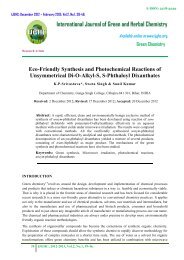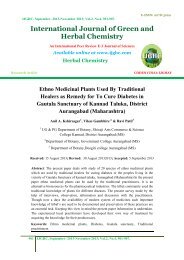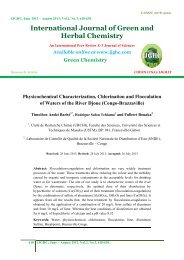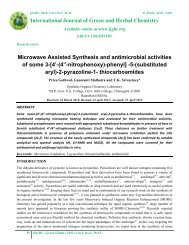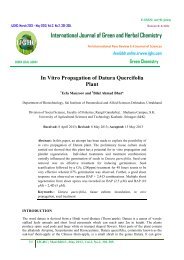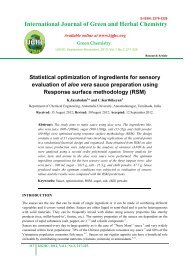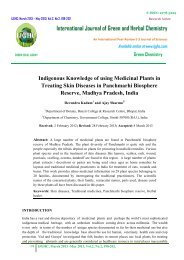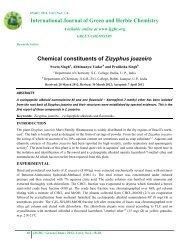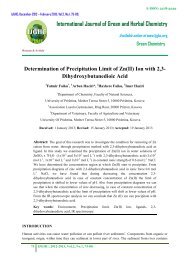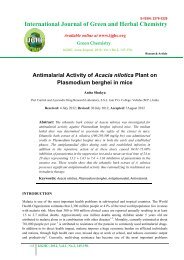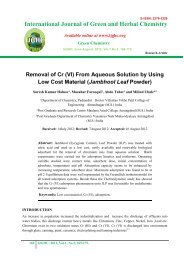Solid Waste Management -A Case Study of Amravati City ... - IJGHC
Solid Waste Management -A Case Study of Amravati City ... - IJGHC
Solid Waste Management -A Case Study of Amravati City ... - IJGHC
Create successful ePaper yourself
Turn your PDF publications into a flip-book with our unique Google optimized e-Paper software.
E-ISSN: 2278-3229<br />
International Journal <strong>of</strong> Green and Herbal Chemistry<br />
Available online at www.ijghc.org<br />
Green Chemistry<br />
<strong>IJGHC</strong>; September-November, 2012; Vol.1.No.3, 245-255.<br />
Research Article<br />
<strong>Solid</strong> <strong>Waste</strong> <strong>Management</strong> -A <strong>Case</strong> <strong>Study</strong> <strong>of</strong> <strong>Amravati</strong> <strong>City</strong>,<br />
Maharashtra<br />
Shivasharanappa 1* , Milind M Shrirao 1<br />
1* Department <strong>of</strong> Civil Engineering, P. D. A. College <strong>of</strong> Engineering<br />
(Autonomous Institution) Gulbarga, Karnataka State, India.<br />
Received: 2 September 2012; Revised: 19 September 2012; Accepted: 25 September 2012.<br />
Abstract: Existing municipal solid waste management by <strong>Amravati</strong> Municipal<br />
Corporation was studied extensively in respect <strong>of</strong> collection, transportation, and<br />
disposal methods. <strong>Solid</strong> wastes from seven locations <strong>of</strong> the study area were<br />
analyzed for physical, chemical and other parameters. Optimization studies <strong>of</strong><br />
transfer and transportation <strong>of</strong> solid waste also studied so as to arrive at appropriate<br />
routes and haul costs to the existing methodologies.<br />
Keywords: <strong>Solid</strong> <strong>Waste</strong> <strong>Management</strong>, Physical components, Chemical<br />
characteristics, Optimisation, Haul cost.<br />
INTRODUCTION<br />
The word 'waste' refers to useless, unwanted or discarded materials which are no longer considered <strong>of</strong><br />
sufficient value and are thrown away by the possessor <strong>Waste</strong> include solid, liquid and gaseous. The wastes<br />
in the solid or semisolid forms are called "<strong>Solid</strong> <strong>Waste</strong>s". <strong>Solid</strong> wastes are Classed or refused. Refuse<br />
comprises all <strong>of</strong> solid wastes resulting from the normal activities <strong>of</strong> the community except excreta. <strong>Solid</strong><br />
<strong>Waste</strong> <strong>Management</strong> is the discipline associated with the control <strong>of</strong> generation, storage, collection, transfer,<br />
processing and disposal <strong>of</strong> solid waste with the best principles <strong>of</strong> public health, economies, engineering<br />
conservation aesthetics and other environmental considerations and that is also responsive to public<br />
attitudes. In its scope solid waste management includes all administrative, financial, legal planning and<br />
engineering, functions involved in solutions to all problems <strong>of</strong> solid wastes. The solutions may involve<br />
complex interdisciplinary relationships among such fields as political science, city and regional planning,<br />
geography, economics, public health, sociology, demography, communications, and conservation as well<br />
as engineering and material science.<br />
245 <strong>IJGHC</strong>; 2012, Vol.1, No.3, 245-255.
<strong>Solid</strong> <strong>Waste</strong>...<br />
Shivasharanappa and Milind M Shrirao.<br />
Objectives <strong>of</strong> the <strong>Study</strong>:<br />
1. Characterization <strong>of</strong> solid waste <strong>of</strong> <strong>Amravati</strong> city.<br />
2. To study the existing system <strong>of</strong> collection, transportation and disposal <strong>of</strong> solid waste <strong>of</strong> <strong>Amravati</strong><br />
Municipal Corporation<br />
3. To optimize transportation through economical way from transfer station to disposal site.<br />
4. To suggest treatment method for different refuse as per requirement.<br />
5. To suggest number <strong>of</strong> containers at transfer point as per requirement.<br />
MATERIALS AND METHODS<br />
In 1853, the present day territory <strong>of</strong> <strong>Amravati</strong> district as a part <strong>of</strong> Berar Province was assigned to the<br />
British East India Company, following a treaty with the Nizam <strong>of</strong> Hyderabad. In 1956, <strong>Amravati</strong> district<br />
became part <strong>of</strong> Bombay State and after its bifurcation in 1960; it became part <strong>of</strong> Maharashtra State.<br />
Location map <strong>of</strong> <strong>Amravati</strong> city is presented in Fig.1.<br />
Educational: Educationally <strong>Amravati</strong> city is one <strong>of</strong> the main educational centres in Maharashtra state as<br />
well as in country. <strong>Amravati</strong> University provides best courses for students across the country. 6<br />
Engineering Colleges & 1 Medical College are in <strong>Amravati</strong> city.<br />
246 <strong>IJGHC</strong>; 2012, Vol.1, No.3, 245-255.
<strong>Solid</strong> Waist...<br />
Shivasharanappa Milind M Shrirao.<br />
Climate: Temperature ranges from 17.8 o C during winter to 34.4 o C during summer, Humidity varies<br />
from 14% during summer to 33% during rainy days.<br />
CONFIGURATION<br />
The latitude and longitude <strong>of</strong> <strong>Amravati</strong> is 20° 56' 0" N / 77° 45' 0" E<br />
Geology: Northern part <strong>of</strong> district is mostly hilly area & covered by forest. The North West part is cover<br />
by thick forest <strong>of</strong> teak. The central part is covered by Purna alluvium, total area is 3053 sq km. The Purna<br />
alluvium consist <strong>of</strong> silt, clay, sand, while Bazada zone foothill portion <strong>of</strong> Satpuda range covers part <strong>of</strong><br />
Anjangaon, Surji, Achalpur & Chandur bazar taluka consisting <strong>of</strong> clay, boulders & pebbles. The total<br />
coverage <strong>of</strong> this area is 25% while other 75% area is Deccan trap mostly jointed vesicular basalt type.<br />
Present status <strong>of</strong> solid waste management in <strong>Amravati</strong> <strong>City</strong>: In the present study we have gathered some<br />
important information through visits at various sites <strong>of</strong> Municipal Corporation <strong>of</strong> <strong>Amravati</strong> <strong>City</strong>, also<br />
meeting with the employees <strong>of</strong> M.C.A those who are involved in solid waste management program.<br />
M.C.A area is121.65 sq km divided in four Prabhag Samitis, which are divided into 27 electoral zones<br />
(Table 1). There are various agencies, which produces the various solid wastes such as hospital, vegetable<br />
market, domestic etc. At present AMC has provided about 450 containers, for various areas to collect<br />
refuse is shows in Table 2. In some area one container is insufficient because some area is densely<br />
populated. But in some areas, single container is sufficient for some developed area such as camp,<br />
Mangilal plot etc. At present there is only one disposal point available in AMC which is "Sukali disposal<br />
(station) depot" but its capacity is inadequate from last five to six years. Even though the AMC used this<br />
depot since from 30 year, that time this depot was 8.00 km away from the city, but due to increases in<br />
population <strong>of</strong> city and civilian area, <strong>Amravati</strong> Nagar Palika got converted into Municipal Corporation.<br />
Now the depot is 0.5 to 0.75 km away from the city (i.e. distance is measured from the end house <strong>of</strong> city).<br />
In <strong>Amravati</strong> city, on an average 200 to 250 MT <strong>of</strong> solid waste is generated per day <strong>of</strong> various types such<br />
as glass, plastics, house refuse, kitchen waste, sand, silt, debris, paper etc. excluding bio- medical hazards<br />
wastes, industrial wastes, etc.<br />
From the information <strong>of</strong> AMC solid waste management and disposal, contract was taken by "Puja<br />
Construction Company". Company uses 10 tracks and 12 dumper places, but user dumper place is only<br />
half percentage. <strong>Amravati</strong> city is surveyed and after observing the problem and discussion with the local<br />
people <strong>of</strong> the area, it is suggested for improvement <strong>of</strong> disposing solid waste in container and their nos. as<br />
per required & existing position shown in Table 3. The management <strong>of</strong> solid waste system is not proper;<br />
it is hence desirable that necessary pr<strong>of</strong>essional leadership is provided for good organization. On present<br />
disposal site there is only the dumping <strong>of</strong> solid waste is going on at randomly and there is not separation<br />
<strong>of</strong> organic and inorganic material due to which there is lot <strong>of</strong> odour nuisance & fly nuisance. For this<br />
project, AMC area is divided in seven zones called transfer station for collection <strong>of</strong> MSW, which should<br />
be easily accessible and there should not be any objection by the people and five disposal sites are<br />
selected beyond the <strong>Amravati</strong> city. The distance between transfer stations to disposal site is shown in the<br />
Table 4. Presently AMC adopted only dumping at site and no treatment is done. No open wells/ bore<br />
wells reported in the dumping area.<br />
Present <strong>Study</strong>: Quantity and Characteristics <strong>of</strong> solid waste depends upon various factors such as lifestyle,<br />
food habits, standard <strong>of</strong> living, the extent <strong>of</strong> industrial and commercial activities in the area, cultural<br />
traditions <strong>of</strong> inhabitants, climate etc. Several studies, Karthikeyan (2008), Prasad (2008), Prasad,<br />
Karthikeyan and Srivastava (2009) have assessed Quantity and Characteristics <strong>of</strong> Municipal <strong>Solid</strong> <strong>Waste</strong><br />
generated in Tirupati. In this study quantity, characteristics <strong>of</strong> solid waste and optimisation studies were<br />
carried out.<br />
247 <strong>IJGHC</strong>; 2012, Vol.1, No.3, 245-255.
<strong>Solid</strong> <strong>Waste</strong>...<br />
Shivasharanappa and Milind M Shrirao.<br />
Table-1: Prabhag Samitis <strong>of</strong> AMC with their electoral zones.<br />
Prabhag<br />
samitis<br />
4<br />
4 wards<br />
Prabhag<br />
samitis<br />
Electoral<br />
zone- no.<br />
Prabhag<br />
samitis<br />
Electoral<br />
zone no<br />
Prabhag<br />
samitis<br />
Electoral zone<br />
no<br />
1 V.M.V-01 2 Mahajnpura - 3 Chaparashipura-<br />
Gadgebaba-<br />
10<br />
04<br />
6 wards 02 8 wards Haidrpura -1 8 wards Benoda -05<br />
Vidyapith-<br />
1<br />
Congresnagar-<br />
03<br />
Gombhirpura-<br />
16<br />
Morbag-13<br />
12<br />
Adaneshwar-17<br />
Rampuri-14<br />
Gorokshan -<br />
Ambikanagar-<br />
Shrikrishna<br />
20<br />
18<br />
peth-15<br />
lndrophavan-<br />
Jagechowk -25<br />
21<br />
Vivekananda -<br />
Bhajibazar-23<br />
26<br />
Chayyanager-<br />
Rajapeth -27<br />
23<br />
Nagpurigate-<br />
24<br />
Above Prabhag Samitis have used total container at their transfer station (Table 2)<br />
Electoral zone<br />
no<br />
MIDC- 06<br />
Junivasti-7<br />
Sainagar-09<br />
Dasaramaidan-<br />
19<br />
Table-2: Ward wise containers.<br />
Prabhag<br />
E - wards<br />
Total<br />
Containers Equipment Open<br />
Dumper<br />
Samitis<br />
Population<br />
trucks<br />
Places<br />
1 6 238697 138 DP<br />
2 8 3,02461 100 DP<br />
3 8 304615 146 DP 10 12<br />
4 5 250446 66 DP<br />
Total 27 1096219 450 10 12<br />
248 <strong>IJGHC</strong>; 2012, Vol.1, No.3, 245-255.
<strong>Solid</strong> Waist...<br />
Shivasharanappa Milind M Shrirao.<br />
Table-3: Area wise existing and required container<br />
Transfer<br />
station<br />
Symb<br />
ol<br />
Popul<br />
ation<br />
Transfer<br />
waste<br />
unit/day<br />
Disposal<br />
site<br />
Capacit<br />
y unit<br />
Area<br />
for<br />
disposa<br />
l in<br />
acre<br />
<strong>Waste</strong><br />
generated<br />
in MT<br />
Name <strong>of</strong><br />
Disposal<br />
Site<br />
Badnera<br />
juniwasti<br />
Rajapeth<br />
Market<br />
Yashodh<br />
a Nagar<br />
Chapara<br />
shipura<br />
T1 16369<br />
7<br />
T2-A 12171<br />
4<br />
T2-B 18257<br />
0<br />
T3 20246<br />
1<br />
113 D1 110 5 40.11 Loni<br />
52 D2 177 8 18.26 Bhankhed<br />
a Area<br />
52 D2 177 8 23.55 Bhankhed<br />
a Area<br />
131 D3 154 7 46.57 Rajura<br />
Bhim<br />
Nagar<br />
T4-A<br />
12533<br />
1<br />
101<br />
D4 66 3 36<br />
Rewsa<br />
Shegaon T4-B 94989 53 D4 66 3 18.71 Rewsa<br />
Mahajan<br />
pura<br />
T5 20545<br />
7<br />
123 D5 132 6 43.76 Lontek<br />
D- Disposal site T = transfer station<br />
Table-4: Distance between transfer stations to disposal (All distances in Km.)<br />
Disposal<br />
site<br />
D1 D2 D3 D4 D5<br />
Transfer<br />
station<br />
T1 10.00 17.00 21.00 22.00 12.00<br />
T2-A 16.00 7.00 15.00 19.00 13.00<br />
T2-B 16.50 9.50 15.00 16.00 11.00<br />
T3 19.00 12.50 10.00 16.00 16.50<br />
T4-A 23.00 19.00 15.00 9.00 10.00<br />
T4-B 23.50 17.00 12.00 9.50 12.00<br />
T5 15.00 8.50 16.00 15.50 8.00<br />
249 <strong>IJGHC</strong>; 2012, Vol.1, No.3, 245-255.
<strong>Solid</strong> <strong>Waste</strong>...<br />
Shivasharanappa and Milind M Shrirao.<br />
RESULTS AND DISCUSSION<br />
In the present study we observed physical and chemical characteristics <strong>of</strong> refuse from various areas <strong>of</strong><br />
AMC as per standard methods, and the results are as given below.<br />
Physical Characteristics: The results <strong>of</strong> the physical analysis <strong>of</strong> AMC solid waste were determined by a<br />
wet- weight are shown in Table 5. Chemical Characteristic: The results <strong>of</strong> chemical characteristics <strong>of</strong><br />
AMC solid waste were presented in Table 6.<br />
Optimization <strong>of</strong> Transfer & Transportation <strong>of</strong> Refuse for AMC:<br />
Haul cost: Haul time can be computed by using the equation<br />
Haul time hr/trip = 0.08 hr / trip + 0.025 hr / km<br />
The haul cost assumed Rs. 60 / hr<br />
Solution: The station depends on cost <strong>of</strong> hauling waste from each transfer station to each disposal site<br />
develop a material <strong>of</strong> haul cost which is shown in the Table 7. The cost matrix that follows relates the<br />
cost <strong>of</strong> transfer station unit <strong>of</strong> solid waste from each transfer station (T1) to each disposal site using the<br />
given data.<br />
Example: To compute the haul cost by using above expression.<br />
T1 to D1 = 10.00 km (from Table 4)<br />
Haul cost per unit/ day = 0.08 + 0.025 X 10 = 0.33<br />
Haul cost = 0.33 X 60 = 19.80<br />
Optimality Analysis <strong>of</strong> Transportation: In the transportation matrix, it is compute the lowest cost, for find<br />
the opportunity cost relevant to each row and column. The object is to minimize the cost <strong>of</strong> transportation<br />
while meeting the requirements at the destination. Optimality analysis in transportation consists <strong>of</strong> the<br />
following sub steps from Table 7, 8, 9, 10 & 11. Optimized route is given in Fig.2.<br />
Fig.2: Proposed route optimization<br />
250 <strong>IJGHC</strong>; 2012, Vol.1, No.3, 245-255.
<strong>Solid</strong> Waist...<br />
Shivasharanappa Milind M Shrirao.<br />
Table-5: Physical characteristic <strong>of</strong> refuse <strong>of</strong> AMC (All values in % by weight)<br />
Area / ward Paper Plastics Metal Glass Ash<br />
Organic<br />
Matter<br />
Badnera<br />
Junction<br />
5.60 5.60 10.10 5.60 11.10 20.25<br />
Rajapeth Market 10.10 3.30 6.70 3.30 23.30 19.25<br />
Yashoda Nagar 14.30 17.14 5.80 8.60 12.38 19.23<br />
Chaparashipura 2.20 2.20 6.50 2.20 13.00 23.15<br />
Bhim<br />
Nagar<br />
4.40 5.60 10.00 10.00 10.40 25.26<br />
Shegaon 2.40 8.30 4.45 10.90 11.47 26.27<br />
Mahajan Pura 9.90 9.30 3.30 7.27 9.26 25.27<br />
Table-6: Chemical characteristics <strong>of</strong> refuse <strong>of</strong> AMC (All values in % by weight)<br />
Area/<br />
ward<br />
Badnera<br />
juniwasti<br />
Rajapeth<br />
market<br />
Yashoda<br />
Nagar<br />
Chapara<br />
shipura<br />
Bhim Nagar<br />
Shegaon Mahajanpura<br />
Moisture<br />
content<br />
Organic<br />
matter<br />
22.19 16.23 17.25 19.28 15.25 17.27 24.23<br />
20.25 19.25 19.23 23.15 25.26 26.27 25.27<br />
C% 12.56 12.51 11.95 15.32 25.30 15.80 14.2<br />
N% 0.60 0.61 0.55 0.58 0.6 0.20 0.42<br />
P as P2 O5<br />
%<br />
K as K2 O<br />
%<br />
0.70 0.71 0.67 0.59 0.10 0.20<br />
0.70 0.73 0.72 0.67 0.25 0.40<br />
0.24<br />
0.54<br />
C/N 20.35 20.47 21.45 26.23 48.50 15.30 18.90<br />
Ph 7.2 7.3 7.6 8.1 8.4 6.9 7.1<br />
Density<br />
kg/m3<br />
375 350 320 300 400 370 420<br />
251 <strong>IJGHC</strong>; 2012, Vol.1, No.3, 245-255.
<strong>Solid</strong> <strong>Waste</strong>...<br />
Shivasharanappa and Milind M Shrirao.<br />
Table-7: Distance form transport station to disposal site. (All distances in km)<br />
Disposal Site D1 D2 D3 D4 D5<br />
Transfer<br />
Station<br />
Container<br />
Provided<br />
Container<br />
Required<br />
T1 10.0 17.00 21.00 22.00 12.00 66 113<br />
T2-A 16.00 7.00 15.00 19.00 13.00<br />
T2-B 16.50 9.50 15.00 16.00 11.00<br />
100 118<br />
T3 19.00 12.50 10.00 16.00 16.50 84 131<br />
T4-A 23.00 19.00 15.00 9.00 10.00<br />
T4-B 23.50 17.00 12.00 9.50 12.00<br />
120 154<br />
T5 15.00 8.50 16.00 15.00 8.00 80 123<br />
Table-8: Modified haul cost.<br />
Transfer<br />
Station<br />
Disposal Sites<br />
D1 D2 D3 D4 D5<br />
T1 19.80 30.30 36.30 37.80 22.80<br />
T2 29.18 17.18 27.30 31.05 22.80<br />
T3 33.30 23.55 19.80 28.80 29.55<br />
T4 39.68 31.80 25.05 18.68 21.23<br />
T5 27.30 17.55 28.80 28.05 16.80<br />
252 <strong>IJGHC</strong>; 2012, Vol.1, No.3, 245-255.
<strong>Solid</strong> Waist...<br />
Shivasharanappa Milind M Shrirao.<br />
Table-9: Solution matrix showing allocation <strong>of</strong> waste in unit / day.<br />
Transfer Station<br />
Disposal Sites<br />
D1 D2 D3 D4 D5<br />
T1 113<br />
T2 118<br />
T3 131<br />
T4 154<br />
T5 123<br />
Table-10: The above repetition made in single matrix.<br />
Transfer<br />
Station<br />
Disposal Site<br />
D1 D2 D3 D4 D5<br />
T1 19.80 30.30 36.30 37.80 22.80<br />
T2 29.18 17.18 27.30 31.05 22.80<br />
T3 33.30 23.55 19.80 28.80 29.55<br />
T4 39.68 31.80 25.05 18.68 21.23<br />
T5 27.30 17.55 28.80 28.05 16.80<br />
Table-11: Haul operation.<br />
From To Unit Haul Cost<br />
Per Unit Cost Total Cost<br />
T1 D1 113 19.80 2237.4<br />
T2 D2 118 17.18 2027.24<br />
T3 D3 131 19.80 2593.8<br />
T4 D2 154 31.80 4897.2<br />
T5 D5 123 16.80 2066.4<br />
Total Cost in Rupees 13822.04<br />
CONCLUSIONS<br />
From the study and on the basis <strong>of</strong> information & survey conducted in the city some conclusions and<br />
suggestions are drawn. As the AMC used only one disposal site but its capacity is inadequate from last<br />
five years, and hence there should be five disposal sites for convenient disposal <strong>of</strong> MSW from seven<br />
253 <strong>IJGHC</strong>; 2012, Vol.1, No.3, 245-255.
<strong>Solid</strong> <strong>Waste</strong>...<br />
Shivasharanappa and Milind M Shrirao.<br />
transfer stations. Containers should be provided at separate compartment, one for wet waste and other for<br />
dry waste, at transfer station. In each transfer area solid waste should be stored separately in dustbin by<br />
house owner. If the two or three area are nearer to each other, there should be one common point for the<br />
collection <strong>of</strong> container, at that point there should be a provision <strong>of</strong> empty stand-by containers, i.e. when<br />
filled up container brought to that common point, empty stand-by container can be replaced by the filled<br />
up container. The allocated points for the container should not be far away, other wise the people will face<br />
the problem <strong>of</strong> disposal <strong>of</strong> refuse. Some places required more number <strong>of</strong> containers such as vegetable<br />
market, where huge quantity <strong>of</strong> waste generated creates the odour and nuisance, so waste should be<br />
collected in container and disposed <strong>of</strong>f regularly to disposal site for healthy environment. <strong>Amravati</strong><br />
Municipal Corporation may impose rules and regulation for contractors to increase more number <strong>of</strong><br />
sweepers to collect the refuse for working at different shifts so as to run proper functioning <strong>of</strong> system.<br />
Land fill site shall be fenced. The land fill site should be away from habitation clusters, forest areas, water<br />
bodies, monuments, national parks, wetlands and places <strong>of</strong> important cultural, historical, religious interest.<br />
Plantation should be provided at landfill site. Still the scope for further work remains that, is composting<br />
<strong>of</strong> solid waste and quantity <strong>of</strong> manure, after composting use <strong>of</strong> composted matter, effectiveness <strong>of</strong> manure<br />
on plant growth etc. Optimization suggested to transportation should be followed.<br />
REFERENCES<br />
1. P. Lakshmi Narayana Prasad , J. Karthikeyan and R.C. Srivastava -SWM and Material<br />
recovery in an urban area in India- A <strong>Case</strong> <strong>Study</strong> <strong>of</strong> Tirupati Municipal Corporation – The<br />
24 th International conference on <strong>Solid</strong> <strong>Waste</strong> Technology and <strong>Management</strong>, March 2009,<br />
Philadelphia, U.S.A.<br />
2. J. Karthikeyan, A <strong>Study</strong> on status <strong>of</strong> <strong>Solid</strong> <strong>Waste</strong> <strong>Management</strong> in Tirupati, Research project<br />
sponsored by government <strong>of</strong> India and World Bank through TEQIP under services to<br />
community and Economy, 2008<br />
3. P.L.N. Prasad, <strong>Solid</strong> <strong>Waste</strong> <strong>Management</strong> and waste recycling in Tirupati Municipal<br />
Corporation – A <strong>Study</strong>. M.E Thesis All India Institute <strong>of</strong> Hygiene and public health,<br />
Kolkata, 2008.<br />
4. Sunil Kumar, J.K.Bhattacharyya, A.N.Vaidya, Tapan Chakrabarti, Sukumar Devotta,<br />
A.B.Akolkar, <strong>Waste</strong> <strong>Management</strong>, Assessment <strong>of</strong> the Status <strong>of</strong> Municipal solid <strong>Waste</strong><br />
<strong>Management</strong> in Metro cities, State Capitals, Class I Cities, and Class II towns in India:<br />
An insight from NEERI.<br />
5. Syeda Azeem Unnisa, S. Bhupatthi Rav, Sustainable <strong>Solid</strong> <strong>Waste</strong> <strong>Management</strong>, Apple<br />
Academic Press, 2012.<br />
6. Nicholas P Cheremisin<strong>of</strong>f, Handbook <strong>of</strong> solid waste management and waste, Minimization,<br />
Butterworth Heinemann Publications, 2002.<br />
7. Sunderesan and Bhide, <strong>Solid</strong> <strong>Waste</strong> <strong>Management</strong>, 1989.<br />
*Correspondence Author: Shivasharanappa; Associate Pr<strong>of</strong>essor, Dept <strong>of</strong> Civil<br />
Engineering, P. D. A. College <strong>of</strong> Engineering (Autonomous Institution) Gulbarga,<br />
Karnataka State, India<br />
254 <strong>IJGHC</strong>; 2012, Vol.1, No.3, 245-255.



